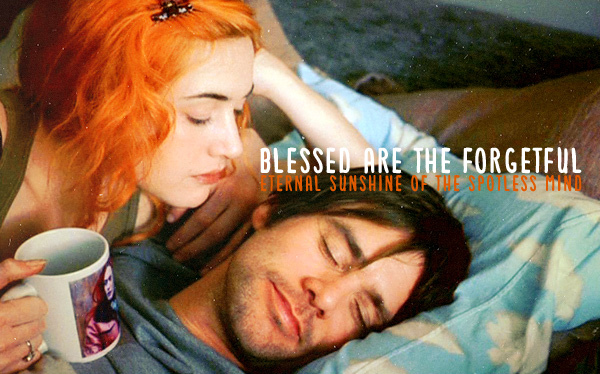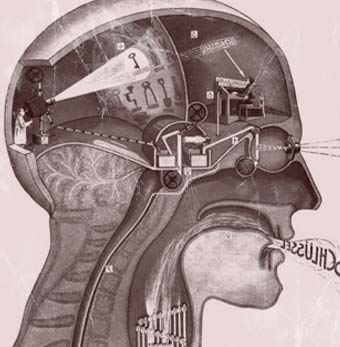“Eternal Sunshine of a Spotless Mind” is my favorite movie. I think it’s perfect. I’ve seen it almost a dozen times. What kept me watching was the premise of being able to erase selected parts of your own memory to get rid of traumatic events and people one would prefer to forget. I was also fascinated by the tragicomic notion of people, again, falling in love with the same people they paid the memory service to delete.

However, the premise of the movie relies on the notion that our memories of events are fixed. The movie portrayed memory as visual episodes that deconstruct as the process of memory deletion proceeds; meaning, there was something (a unit of memory, perhaps) to delete to begin with.
Recent experiments done prove otherwise. You don’t have to delete your memories, because they are not real to begin with.
Let’s have a quick thought experiment:
1) Try to recall a moment in your life when you were at the beach with friends.
2) Try to imagine being at the beach with friends.
Images that you imagine and images that you remember look and feel exactly the same. That’s because they are. Memory is malleable.
Trust Your Memory?
Jaque Wilson, from CNN, wrote the article, “Trust your memory? Maybe you shouldn’t.” This article was about experiments done by Elizabeth Loftus in her attempt to demonstrate how “fictional” our memory is.
The first experiment had to do with car crashes. She showed videos of different car accidents and asked people about what they remembered about them. She noticed how their recollection of the incident was influenced by what questions she asked.
When she asked “How fast were the cars moving when they smashed into each other?” instead of “How fast were the cars moving when they hit each other?,” people believed the cars to be moving at a much faster speed. When she asked “Did you see the broken headlight?” instead of “Did you see a broken headlight?” people were more likely to remember a broken headlight, even if there wasn’t one to begin with.
Needless to say, the information people gather after an event, greatly influences how they remember the event. When we try to remember an incident, we are not merely trying to “recollect or recapture old information,” we are, in fact, “fabricating or creating memories based on new information.”
In her Ted Talk (It’s a mind-fuck. Go watch it!), “The Fiction of Memory,” Elizabeth Loftus says, “Many people believe that memory works like a recording device; you just record the information, then you call it up and play it back when you want to answer questions or identify images, but decades of work in psychology has shown that this just isn’t true. Our memories are constructive, they’re reconstructive. Memory works more like a Wikipedia page. You can change it, but so can other people.”
To further prove how memories are fabricated, she wrote a research report on another experiment entitled, “The Formation of False Memories.” In this experiment, close family members of 24 students were asked to give them 3 real childhood memories of the student and 1 false one. The students were told that all 4 childhood memories were real. Some of them were even asked to provide details about the fake memories. 29% of the participants were able to recall, with detail, events that did not happen.

Two Kinds of Memory
So, how does this happen? You might be thinking, “Dustin, are you telling us that if someone told you that your name was Brad Pitt, and not Dustin, you would believe him?” No, I would not, but I would be very flattered. Also, that’s not how memory works, especially as it relates to what we know about ourselves and who we think we are.
There are two kinds of memory:
1) Semantic Memory – a record of facts, meanings, concepts and knowledge.
2) Episodic Memory – memory of experiences and specific events in time in a serial form.
Our idea of who we are, our identity, is based on both types of memory. However, since memory is malleable, so is our identity. Initially, it was believed that our semantic notions or knowledge of the self (“I am an asshole”) is based on episodic memories (images we can reconstruct that show us being “assholes”; e.g. bullying service personnel).
However, the experiments of Loftus reveal that it could also work the other way around. When we encounter new information (someone calls us an “asshole”), our brain cherry picks or constructs images that verify the information.
In other words, other people can change what you remember, and who you think you are. As Loftus says, “Memory works like a Wikipage.” And just like a Wikipage, it can be changed or updated today or tomorrow, and by anyone.
I’m usually skeptical about self-help products or advice. However, in my opinion, this information does imply that “optimism” and being around “optimistic people” will make you a happier person simply by compelling you to remember your life as mostly a positive experience.
Present stimuli influence memories of the past. How you remember things, people, places and events, is a reflection of your current attitude towards them.
I think Marcel Proust, in his literary masterpiece “In Search of Lost Time,” demonstrated the inherent complications of attempts at recollection. Remembering, in this work, is portrayed as elusive, artificial, and creative. There is a lot of emotion involved as well. One can never recall with complete objectivity, especially incidents that are emotionally charged. The very act of recollection is a creative endeavor.
We re-create our own memories very similarly to how a director would interpret a scene from a script. However, we don’t really stick to one interpretation. We constantly change the script and the style of interpreting depending on a variety of factors which include: our mood, new information about the incident, other people’s opinions, etc.
I would like to end this article with a YouTube video called “1 Scene, 9 Directors.” It’s a humorous take on how one simple scene could be imagined in very different ways. I think how our memory works isn’t too far off: https://www.youtube.com/watch?v=MNywbNljhoM
Sources:
Garcia, B. (2012, February). “1 Scene, 9 Directors.” Retrieved on May 15, 2014. From: https://www.youtube.com/watch?v=MNywbNljhoM
Loftus, E. (2013, September). “The Fiction of Memory.” Retrieved on May 15, 2014. From: https://www.youtube.com/watch?v=PB2OegI6wvI
Loftus, E. (1995, December). “The Formation of False Memories.” Retrieved on May 15, 2014. From: https://webfiles.uci.edu/eloftus/Loftus_Pickrell_PA_95.pdf
The Human Memory (2010). “Episodic & Semantic Memory.” Retrieved on May 15, 2014. From: http://www.human-memory.net/types_episodic.html
Wilson, J. (2013, May). “Trust Your Memory? Maybe You Shouldn’t.” Retrieved on May 15, 2014. From: http://edition.cnn.com/2013/05/18/health/lifeswork-loftus-memory-malleability/
Images Borrowed From:
http://krissacurran.files.wordpress.com/2011/12/eternal-sunshine-of-the-spotless-mind.jpg
http://stringcan.com/wp-content/uploads/2013/10/memory1.jpg

